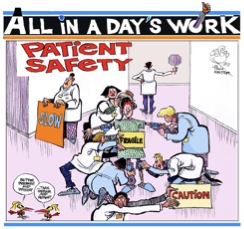Keeping patients safe is hard work, as this cartoon humorously shows us:
Our top 4 reads for this week:
1. The Case for Continuous Patient Monitoring
In this thoughtful article published in Forbes, Robert J. Szczerba discusses the “death” of former Michigan State Trooper Matt Whitman on April 7, 2003;, why Matt’s experience makes a case for continuous electronic monitoring of all patients receiving opioids; and what the National Coalition to Promote Continuous Monitoring of Patients on Opioids is doing to improve health outcomes and patient safety.
For Matt’s own article on how a nurse saved his life and why hospitals should be required to continuously electronically monitor, please click here.
'On April 17, 2003, I Died' - What You Need To Know About #Lifesaving #Technologies #ptsafety Click To TweetThe Physician-Patient Alliance for Health & Safety issued the following statement encouraging the continuous electronic monitoring of all patients receiving opioids:
To improve patient safety and save patients’ lives, we recommend adopting continuous respiratory monitoring of all patients receiving opioids with pulse oximetry for oxygenation and with capnography for adequacy of ventilation to improve timely recognition of respiratory depression, decompensation or clinical deterioration.
To improve #ptsafety and save lives, we recommend adopting continuous #respiratory monitoring of all patients receiving #opioids Click To Tweet2. Use Oximetry to Diagnose Severe Obstructive Sleep Apnea
The American Sleep Apnea Association estimates that 22 million Americans suffer from sleep apnea and that 80 percent of moderate and severe obstructive sleep apnea (OSA) is undiagnosed.
Researchers concluded that using a pulse oximetry on a patient overnight can provide satisfactory diagnostic performance in detecting severe OSA patients.
3. Interoperability = Patient Safety
Interoperability = Patient Safety
That’s a formula that best summarizes a recent nurses’ survey, which concluded:
Meaningful progress in reducing medical errors requires using technology to create an automated, connected, and coordinated healthcare system. And this is only possible when there is a seamless flow of information among all device involved in caring for a patient.
#Interoperability = #PatientSafety #ptsafety Click To Tweet4. Steer Clear of These Six Orthopedic Procedures
Dr. Kenny Lin, who wrote a great article on pregnancy and bed rest, discusses six orthopedic procedures which are frequently performed, but show little or no patient benefit:
- Vertebroplasty for spinal compression fractures
- Rotator cuff repair for non-traumatic tears in older adults
- Clavicle fracture plating in adolescents
- Anterior cruciate ligament (ACL) reconstruction
- Partial medial meniscectomy for adults with knee osteoarthritis and no mechanical symptoms
- Surgery for adults with displaced proximal humerus fractures
